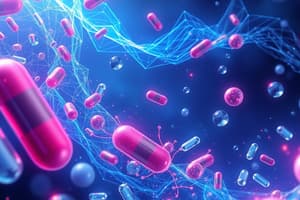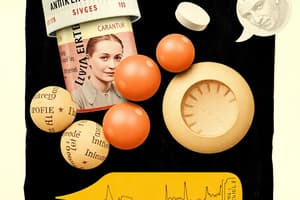Podcast
Questions and Answers
What is the primary function of apolipoproteins in relation to lipids?
What is the primary function of apolipoproteins in relation to lipids?
- To convert lipids into water-soluble substances.
- To synthesize lipids within the bloodstream.
- To transport water-insoluble fats in the blood. (correct)
- To break down lipids for energy.
Which organ plays a major role in lipid metabolism and also manufactures cholesterol?
Which organ plays a major role in lipid metabolism and also manufactures cholesterol?
- Spleen
- Liver (correct)
- Kidney
- Pancreas
A patient has a lipoprotein profile indicating a combination of triglyceride and cholesterol attached to an apolipoprotein. What is this combination called?
A patient has a lipoprotein profile indicating a combination of triglyceride and cholesterol attached to an apolipoprotein. What is this combination called?
- Chylomicron
- Adipocyte
- Micelle
- Lipoprotein (correct)
Which type of lipoprotein is known for being responsible for the 'recycling' of cholesterol?
Which type of lipoprotein is known for being responsible for the 'recycling' of cholesterol?
What is the implication of having low levels of High-Density Lipoprotein (HDL)?
What is the implication of having low levels of High-Density Lipoprotein (HDL)?
What is the significance of a patient having a total cholesterol level of 300 mg/dL, compared to levels less than 200 mg/dL?
What is the significance of a patient having a total cholesterol level of 300 mg/dL, compared to levels less than 200 mg/dL?
For a patient with no existing CVD or diabetes, what LDL level and risk factors would prompt consideration of drug therapy after lifestyle interventions fail?
For a patient with no existing CVD or diabetes, what LDL level and risk factors would prompt consideration of drug therapy after lifestyle interventions fail?
What is the typical first step in managing high cholesterol before drug therapy is considered?
What is the typical first step in managing high cholesterol before drug therapy is considered?
When should baseline cholesterol, HDL, LDL, triglycerides, and renal and liver function tests be monitored when a patient starts HMG-CoA reductase inhibitors?
When should baseline cholesterol, HDL, LDL, triglycerides, and renal and liver function tests be monitored when a patient starts HMG-CoA reductase inhibitors?
Why should HMG-CoA reductase inhibitors typically be administered in the evening?
Why should HMG-CoA reductase inhibitors typically be administered in the evening?
How do HMG-CoA reductase inhibitors work to lower cholesterol levels?
How do HMG-CoA reductase inhibitors work to lower cholesterol levels?
A patient taking statins reports muscle pain and weakness. What serious adverse effect might they be experiencing?
A patient taking statins reports muscle pain and weakness. What serious adverse effect might they be experiencing?
Which of the following interacts with HMG-CoA reductase inhibitors by delaying their metabolism, potentially leading to increased drug levels and adverse effects?
Which of the following interacts with HMG-CoA reductase inhibitors by delaying their metabolism, potentially leading to increased drug levels and adverse effects?
A patient is prescribed cholestyramine. What key instruction should be given regarding its administration?
A patient is prescribed cholestyramine. What key instruction should be given regarding its administration?
How do bile acid sequestrants lower cholesterol levels in the body?
How do bile acid sequestrants lower cholesterol levels in the body?
What is a common side effect associated with bile acid sequestrants?
What is a common side effect associated with bile acid sequestrants?
A patient taking niacin reports flushing and pruritus. What is the primary cause of these effects?
A patient taking niacin reports flushing and pruritus. What is the primary cause of these effects?
A patient is prescribed a fibric acid derivative. What should the patient be monitored for, considering potential adverse effects?
A patient is prescribed a fibric acid derivative. What should the patient be monitored for, considering potential adverse effects?
Ezetimibe is often combined with which other class of drugs to treat high cholesterol, especially when patients have not responded adequately to monotherapy?
Ezetimibe is often combined with which other class of drugs to treat high cholesterol, especially when patients have not responded adequately to monotherapy?
Identify the intervention with the HIGHEST priority for a patient prescribed niacin to manage hyperlipidemia, especially considering potential adverse effects and patient education?
Identify the intervention with the HIGHEST priority for a patient prescribed niacin to manage hyperlipidemia, especially considering potential adverse effects and patient education?
Flashcards
Antilipemic Drugs
Antilipemic Drugs
Drugs used to lower lipid levels in the blood.
Lipids in the Blood
Lipids in the Blood
Water-insoluble fats that must bind to apolipoproteins to be carried in the blood.
Lipoprotein
Lipoprotein
The combination of triglyceride or cholesterol with apolipoprotein.
Low-Density Lipoprotein (LDL)
Low-Density Lipoprotein (LDL)
Signup and view all the flashcards
High-Density Lipoprotein (HDL)
High-Density Lipoprotein (HDL)
Signup and view all the flashcards
High Total Cholesterol
High Total Cholesterol
Signup and view all the flashcards
HMG-CoA Reductase Inhibitors (Statins)
HMG-CoA Reductase Inhibitors (Statins)
Signup and view all the flashcards
Statin Monitoring
Statin Monitoring
Signup and view all the flashcards
Statin Effects
Statin Effects
Signup and view all the flashcards
Bile Acid Sequestrants
Bile Acid Sequestrants
Signup and view all the flashcards
Colesevelam (Welchol)
Colesevelam (Welchol)
Signup and view all the flashcards
Niacin (Nicotinic Acid)
Niacin (Nicotinic Acid)
Signup and view all the flashcards
Niacin - Effects
Niacin - Effects
Signup and view all the flashcards
Fibric Acid Derivatives (Fibrates)
Fibric Acid Derivatives (Fibrates)
Signup and view all the flashcards
Cholesterol Absorption Inhibitor
Cholesterol Absorption Inhibitor
Signup and view all the flashcards
Cholesterol Absorption Inhibitor - Side effects
Cholesterol Absorption Inhibitor - Side effects
Signup and view all the flashcards
Omega-3 Fatty Acids
Omega-3 Fatty Acids
Signup and view all the flashcards
Garlic
Garlic
Signup and view all the flashcards
Antilipemic Drug Contraindications
Antilipemic Drug Contraindications
Signup and view all the flashcards
Antilipemic Nursing Implications
Antilipemic Nursing Implications
Signup and view all the flashcards
Study Notes
Antilipemic Drugs
- Antilipemic drugs lower lipid levels and are used as an adjunct to diet therapy.
- Drug choice is based on the specific lipid profile of the patient.
- Non-drug means of controlling blood cholesterol levels should be tried for at least 6 months before drug therapy.
Triglycerides and Cholesterol
- Lipids are water-insoluble fats that must be bound to apolipoproteins.
- Apolipoproteins are specialized lipid-carrying proteins.
- The liver is the major organ of lipid metabolism and cholesterol production.
- Lipoprotein is the combination of triglyceride or cholesterol with apolipoprotein.
- Very-low-density lipoprotein (VLDL) is produced by the liver and transports endogenous lipids.
- Low-density lipoprotein (LDL) lab levels decrease.
- High-density lipoprotein (HDL) lab levels increase, and is responsible for "recycling" cholesterol, also known as “good cholesterol".
- Low HDL levels are less than 40 mg/dL.
- Total cholesterol levels of 300 mg/dL are three to four times greater than in patients with levels less than 200 mg/dL.
- As cholesterol increases, the incidence of death from coronary heart disease rises.
Types of Antilipemics
- HMG-CoA reductase inhibitors (HMGs, or statins)
- Bile acid sequestrants
- Niacin (vitamin B3, nicotinic acid)
- Fibric acid derivatives (fibrates)
- Cholesterol absorption inhibitor (Zetia)
- Herbal medications
HMG-CoA Reductase Inhibitors (HMGs, or statins)
- These are the most potent LDL reducers.
- Examples: pravastatin (Pravachol), simvastatin (Zocor), atorvastatin (Lipitor), fluvastatin (Lescol), rosuvastatin (Crestor), pitavastatin (Livalo).
- All are given orally, preferably with the evening meal.
- Baseline cholesterol, HDL, LDL, triglycerides, renal and liver function tests should be monitored before and periodically during therapy.
- Results are seen in 6-8 weeks.
- They inhibit HMG-CoA reductase, used by the liver to produce cholesterol.
- They lower the rate of cholesterol production.
- They are the first-line drug therapy for hypercholesterolemia.
- Outcomes include reduced LDL levels, increased HDL levels, and reduced triglycerides.
- Side Effects; mild GI disturbances, rash, headache, myopathy (muscle pain), which can lead to rhabdomyolysis, elevations in liver enzymes or liver disease and peripheral neuropathy.
- Interactions: oral anticoagulants, erythromycin, antifungals (requires lots of liver function), verapamil, diltiazem, HIV protease inhibitors, amiodarone, and grapefruit juice (delays metabolism of the statin).
Bile Acid Sequestrants
- Bile acid sequestrants may be used along with statins.
- Examples: cholestyramine (Questran), colestipol hydrochloride (Colestid), colesevelam (Welchol, taken orally in tablet form).
- Colesevelam (Welchol) should be taken with food and 8oz of water, and not with other medications.
- They prevent reabsorption of bile acids from the small intestine and bile acids are necessary for absorption of cholesterol.
- Side Effects: constipation, heartburn, nausea, belching, and bloating (generally get better over time).
Niacin (Nicotinic Acid/Vitamin B3)
- Niacin is effective, inexpensive, and often used in combination with other lipid-lowering drugs.
- It decreases triglycerides, total serum cholesterol, and LDL levels, while increasing HDL levels.
- It increases the activity of lipase, breaking down lipids.
- It reduces the metabolism of cholesterol and triglycerides.
- Side Effects: flushing (caused by histamine release; and NSAIDs help), pruritus (due to histamine release), GI distress, hyperglycemia, and hepatotoxicity.
Fibric Acid Derivatives (Fibrates)
- Examples: gemfibrozil (Lopid), fenofibrate (Tricor).
- Outcomes: decreases triglyceride levels and increases HDL.
- Activates lipase and breaks down cholesterol
- Suppresses the release of free fatty acid from adipose tissue.
- Inhibits synthesis of triglycerides in the liver.
- Increases secretion of cholesterol in the bile.
- Side Effects: abdominal discomfort, diarrhea, nausea, blurred vision, headache, increased risk of gallstones, prolonged prothrombin time, abnormal liver studies, and myopathy.
- Interactions: oral anticoagulants and statins, which increase the risk for myositis, myalgias, and rhabdomyolysis.
- Affects lab test reactions, including decreased hemoglobin level, hematocrit value, and white blood cell count, as well as increased activated clotting time, lactate dehydrogenase level, and bilirubin level.
Cholesterol Absorption Inhibitor
- Ezetimibe (Zetia) is often combined with a statin drug.
- It is currently recommended only when patients have not responded to other therapies.
- Outcomes: decreases total cholesterol, LDL and triglyceride levels while increasing HDL levels.
- Action: inhibits absorption of cholesterol secreted in the bile and from food.
- Side Effects: hepatitis and myopathy.
- It is contraindicated in patients who have mild to severe liver disorder.
Herbal Products
- Omega-3 Fatty Acids: used to reduce cholesterol and may cause rash, belching, allergic reactions, and/or potential interactions with anticoagulant drugs.
- Garlic: used as a lipid reducer. Adverse effects include dermatitis, vomiting, diarrhea, flatulence, and antiplatelet activity. Possible interactions with warfarin and diazepam. May enhance bleeding when taken with NSAIDs.
- Flax: Both the seed and oil of the plant are used for hypercholesterolemia. May cause diarrhea and allergic reactions. Possible interactions: antidiabetic drugs and anticoagulant drugs.
Nursing Implications
- Contraindications: include biliary obstruction, liver dysfunction, active liver disease
- Obtain baseline liver function studies
- Patients on long-term therapy may need supplemental fat-soluble vitamins (A, D, K)
- Take medicine with meals to decrease GI upset
- Powder forms must be taken with a liquid, mixed thoroughly (but not stirred), and never taken dry
- Other medications should be taken 1 hour before or 4-6 hours after meals to avoid interference with absorption
- To minimize adverse effects of niacin, start on a low initial dose, increase gradually, and take with meals.
- Small doses of aspirin or NSAIDs may be taken 30 minutes before niacin to minimize cutaneous flushing.
- Inform patients that several weeks are needed to show effectiveness.
- Instruct patients to report persistent GI upset, constipation, abnormal or unusual bleeding, and yellow discoloration of the skin.
- Monitor for adverse effects, including increased liver enzyme studies.
- Monitor for therapeutic effects and reduced cholesterol and triglyceride levels.
Studying That Suits You
Use AI to generate personalized quizzes and flashcards to suit your learning preferences.




